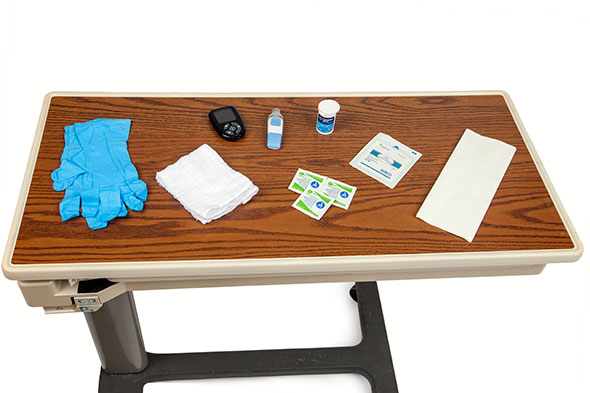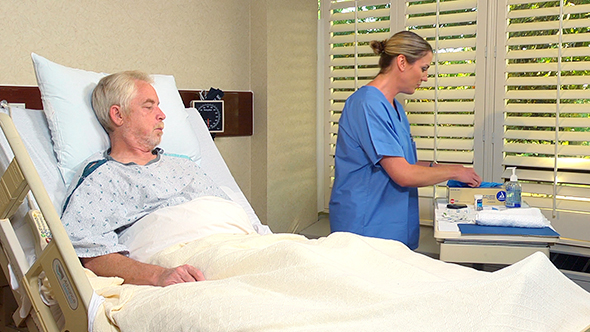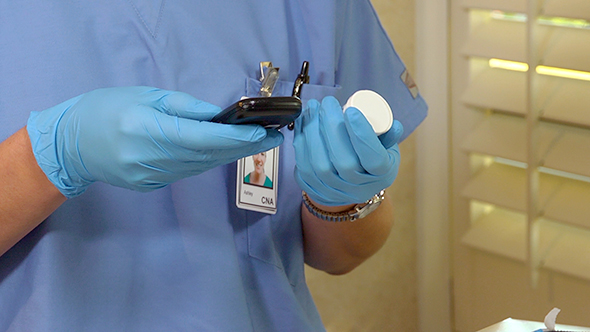Specimen Collection and Surgical Care
Select a Skill:
- » Collecting a Midstream Specimen
- » Collecting a 24-Hour Urine Specimen
- » Collecting and Testing a Stool Specimen
- » Collecting a Sputum Specimen
- » Measuring Blood Glucose
- » The Surgical Skin Prep—Shaving the Skin
- » Assisting with Deep Breathing and Coughing Exercises
Take the Review Test:

Purpose

- Blood glucose testing is used for persons with diabetes. The doctor uses the results to regulate the person’s drugs and diet.
- Capillary blood is obtained through a skin puncture. A drop of blood is collected. A fingertip is the most common site for skin punctures. This provides easy access and clothing is not removed.
- Inspect the puncture site for signs of trauma and skin breaks. Do not use swollen, bruised, cyanotic (bluish), scarred, or calloused sites. Such areas have poor blood flow. Because of calluses, the thumbs and index fingers are not good sites.
- Use the side toward the tip of the middle or ring finger. Do not use the center, fleshy part of the fingertip. The site has many nerve endings making punctures painful.
- Use a sterile, disposable lancet (short, pointed blade) to puncture the skin. The person feels a brief, sharp pinch. The lancet punctures but does not cut the skin. It is inside a protective cover. You do not touch the blade. Discard it into the sharps container after use.
- Using a reagent strip, a glucometer (glucose meter) measures blood glucose. You apply a blood drop to a reagent strip. The blood glucose level appears on the screen. Many types of glucometers are available. How fast results are displayed varies. Some take 5 seconds.
- Learn to use your agency’s device. Always follow the manufacturer’s instructions.
Equipment
Roll cursor over items to see labels. For the purposes of clearly depicting the equipment, a barrier is not shown in this photo. When providing care, a barrier should always be placed on the surface before placing the equipment.

Gloves
Warm wash cloth
Glucometer
Sterile lancet
Antiseptic wipes
Reagent strips (use the correct ones for the glucometer. Check the expiration date.)
2x2 gauze squares
Paper towels
Delegation
- Follow delegation guidelines. If blood glucose testing is delegated to you, make sure that:
- Your state and agency allow you to perform the procedure.
- The procedure is in your job description.
- You have the necessary training.
- You know how to use the agency’s equipment.
- You review the procedure with the nurse.
- The nurse is available to answer questions and to supervise you.
- If the conditions above are met, obtain this information from the nurse and care plan:
- What sites to avoid for a skin puncture
- When to collect and test the specimen—usually before meals
- If the person receives drugs that affect blood clotting (Note: If yes, it may take a longer time to stop bleeding. Apply pressure until bleeding stops.)
- What to report and record
- When to report observations and the test result
- What patient or resident concerns to report at once
Preparation

- Observe quality-of-life measures.
- Review the information under Delegation and Safety and Comfort.
- Practice hand hygiene.
- Collect the equipment.
- Read the manufacturer’s instructions for the lancet and glucometer.
- Disinfect the glucometer. Follow the manufacturer’s instructions for the disinfectant.
- Arrange your work area.
- Identify the person. Check the ID bracelet against the assignment sheet. Also call the person by name.
- Provide for privacy.
- Raise the bed for body mechanics. The far bed rail is up if used.
Safety

- Accurate results are key. Inaccurate results can harm the person. Follow these rules:
- Make sure the glucometer was tested for accuracy. Check the testing log.
- Enter a code or user ID if required by the glucometer. This is provided by the agency. Do not share your user ID with others.
- Compare the code number on the reagent strip with the code number on the glucometer. The code numbers should be the same.
- Scan the bar code on the bottle of reagent strips if needed.
- Check the color of the reagent strips. Do not use discolored strips.
- Check the expiration date on the reagent strips. Do not use outdated strips.
- Report the result to the nurse at once, following agency policy.
- Follow the manufacturer’s instructions for the glucometer and disinfectant. Know how to use the equipment. Request training if needed.
- Use only the type of reagent strip specified by the manufacturer. Otherwise, you will get inaccurate results.
- Disinfect the glucometer after testing a patient or resident. Follow the manufacturer’s instructions for the disinfectant used. Always follow the time set by the manufacturer.
- Contact with blood is likely. Follow Standard Precautions and the Bloodborne Pathogen Standard.
Comfort
- The heel is used for skin punctures in infants who are not walking. The third finger (ring finger) is used for children.
- Older persons often have poor circulation in their fingers. To increase blood flow, apply a warm washcloth or wash the hands in warm water.
Procedure Video
Audio Description: OFFFollow-up Care

- Provide for comfort.
- Place the call light within reach.
- Lower the bed to its lowest position. Raise or lower bed rails. Follow the care plan.
- Unscreen the person.
- Discard used supplies.
- Complete a safety check of the room.
- Follow agency policy for soiled linen.
- Disinfect the glucometer. (Wear gloves.) Follow the manufacturer’s instructions. Return the device to its proper place.
- Remove and discard the gloves. Practice hand hygiene.
Reporting/Recording
- Report and record your observations, including:
- The time the specimen was collected
- The blood glucose test result
- The site used for the skin puncture
- The amount of bleeding at the skin puncture site
- Any signs of a hematoma (a swelling that contains blood)
- How the person tolerated the procedure
- Complaints of pain at the skin puncture site
- Other observations or patient or resident complaints
Review Questions
Select the best answer.
1. What type of blood is used to measure blood glucose with a glucometer?
Select the best answer.
2. Which fingers are not usually good sites for obtaining specimens for measuring blood glucose?
Select the best answer.
3. When do you usually collect and test a specimen to measure blood glucose?
Select the best answer.
4. Before collecting a specimen to measure blood glucose, what can you do to increase blood flow to the site?
 Give the person a full glass of water to drink
Give the person a full glass of water to drink Apply a cool washcloth to the site for 3 minutes
Apply a cool washcloth to the site for 3 minutes Raise the person’s finger above his or her waist
Raise the person’s finger above his or her waist Massage the hand and finger toward the puncture site
Massage the hand and finger toward the puncture site
Select the best answer.
5. To collect a specimen for measuring blood glucose, which action should you take?
 Smear the blood onto the reagent strip
Smear the blood onto the reagent strip Lightly touch the reagent strip to the blood drop
Lightly touch the reagent strip to the blood drop Press the reagent strip firmly over the puncture site
Press the reagent strip firmly over the puncture site Collect blood on a gauze square and apply it to the reagent strip
Collect blood on a gauze square and apply it to the reagent strip
You have completed the Review Questions for this skill. To take the Review again select the Start Over button. To proceed to another skill select from the dropdown menu. Select the Home or Back button to proceed to the next section.

